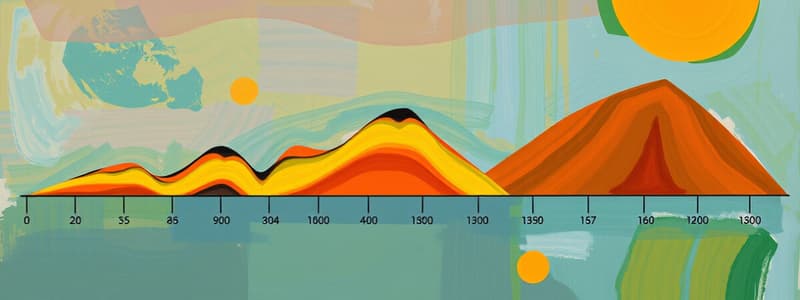Podcast
Questions and Answers
What significant geological event occurred during the Cambrian Period?
What significant geological event occurred during the Cambrian Period?
- Mass extinction of trilobites
- Creation of the supercontinent Gondwanaland (correct)
- Formation of the Atlantic Ocean
- First appearance of jawed fishes
During which period did armored, jawless fishes first appear?
During which period did armored, jawless fishes first appear?
- Silurian Period
- Cambrian Period
- Devonian Period
- Ordovician Period (correct)
What type of life first ventured onto land during the Silurian Period?
What type of life first ventured onto land during the Silurian Period?
- Mosses
- Shrubs
- Psilophytes (correct)
- Flowering plants
Which of the following groups of animals became abundant during the Devonian Period?
Which of the following groups of animals became abundant during the Devonian Period?
What significant change occurred in continental movement during the Ordovician Period?
What significant change occurred in continental movement during the Ordovician Period?
Which periods are part of the Mesozoic era?
Which periods are part of the Mesozoic era?
What significant event marked the end of the Palaeozoic era?
What significant event marked the end of the Palaeozoic era?
What type of plants became major floral groups during the Mesozoic era?
What type of plants became major floral groups during the Mesozoic era?
What was a predominant feature of the Jurassic Period?
What was a predominant feature of the Jurassic Period?
What happened to the dinosaurs at the end of the Cretaceous Period?
What happened to the dinosaurs at the end of the Cretaceous Period?
Flashcards are hidden until you start studying
Study Notes
Geological History of the Earth
- Geology studies the solid Earth, its composition, processes, and a history spanning over 4.5 billion years.
- Geologists address societal challenges regarding energy, water, mineral resources, environment, climate change, and natural hazards.
- The geological history of Earth is understood through the geologic time scale, which categorizes major events based on rock layers (stratigraphy).
Cambrian Period (570-510 million years ago)
- The seas were filled with life, dominated by invertebrates like trilobites.
- First supercontinent, Gondwanaland, formed from multiple plate collisions.
- North America and Eurasia separated from other continents after Pangaea's breakup.
Ordovician Period (510-439 million years ago)
- The Atlantic Ocean began to shrink as continents drifted closer.
- First appearances of corals, crinoids, bryozoans, and jawless fishes within ancient estuary fossils.
Silurian Period (439-408.5 million years ago)
- Simple plants (psilophytes) and scorpion-like eurypterids ventured onto land.
- Trilobites decreased; seas became rich in corals, cephalopods, and jawed fishes.
Devonian Period (408.5-362.5 million years ago)
- Known as the "age of fishes" with diverse fish types, leading to amphibian evolution.
- Dominated by giant ferns on land.
Permian Period (290-245 million years ago)
- Land masses formed Pangaea; Appalachian Mountains emerged in North America.
- Environmental shifts led to a mass extinction, concluding the Palaeozoic era.
Triassic Period (245-208 million years ago)
- Mesozoic era began with Gondwanaland's return; Pangaea split into Laurasia and Gondwanaland.
- Rise of reptiles, including dinosaurs, and new plant families like pteridosperms and conifers.
Jurassic Period (208-145.6 million years ago)
- North Atlantic Ocean widened, marking the fragmentation of Gondwanaland.
- Dominance of giant dinosaurs on land and marine reptiles in oceans; emergence of primitive birds.
Cretaceous Period (145.6-65 million years ago)
- Flourishing and specialization of dinosaurs; a mass extinction event marked the end of this period.
- Significant floral changes with the rise of angiosperms.
Tertiary Period (65-1.64 million years ago)
- North America disconnected from Europe, developing ties with South America.
- The age of mammals emerged following the extinction of dominant reptiles; key mammal groups and species appeared across epochs.
Quaternary Period (1.64 million years ago to present)
- Continental ice sheets covered the northern hemisphere intermittently.
- Early human types emerged; modern humans (Homo sapiens) appeared late in the period.
- Human migration into the New World occurred via the Bering land bridge.
Important Principles of Geology
- Principle of Uniformitarianism: Current geological processes have remained consistent over time.
- Principle of Intrusive Relationships: Igneous intrusions are younger than the sedimentary rocks they crosscut.
- Principle of Inclusion and Components: Inclusions within rocks are older than the rocks containing them.
- Principle of Original Horizontality: Sediments are originally deposited in horizontal layers, supported by modern observations.
- Principle of Superposition: In undisturbed sedimentary sequences, older layers are found beneath younger layers.
- Principle of Faunal Succession: Fossils can help determine the relative ages of sedimentary rocks based on the presence or absence of species across different time periods.
Studying That Suits You
Use AI to generate personalized quizzes and flashcards to suit your learning preferences.




